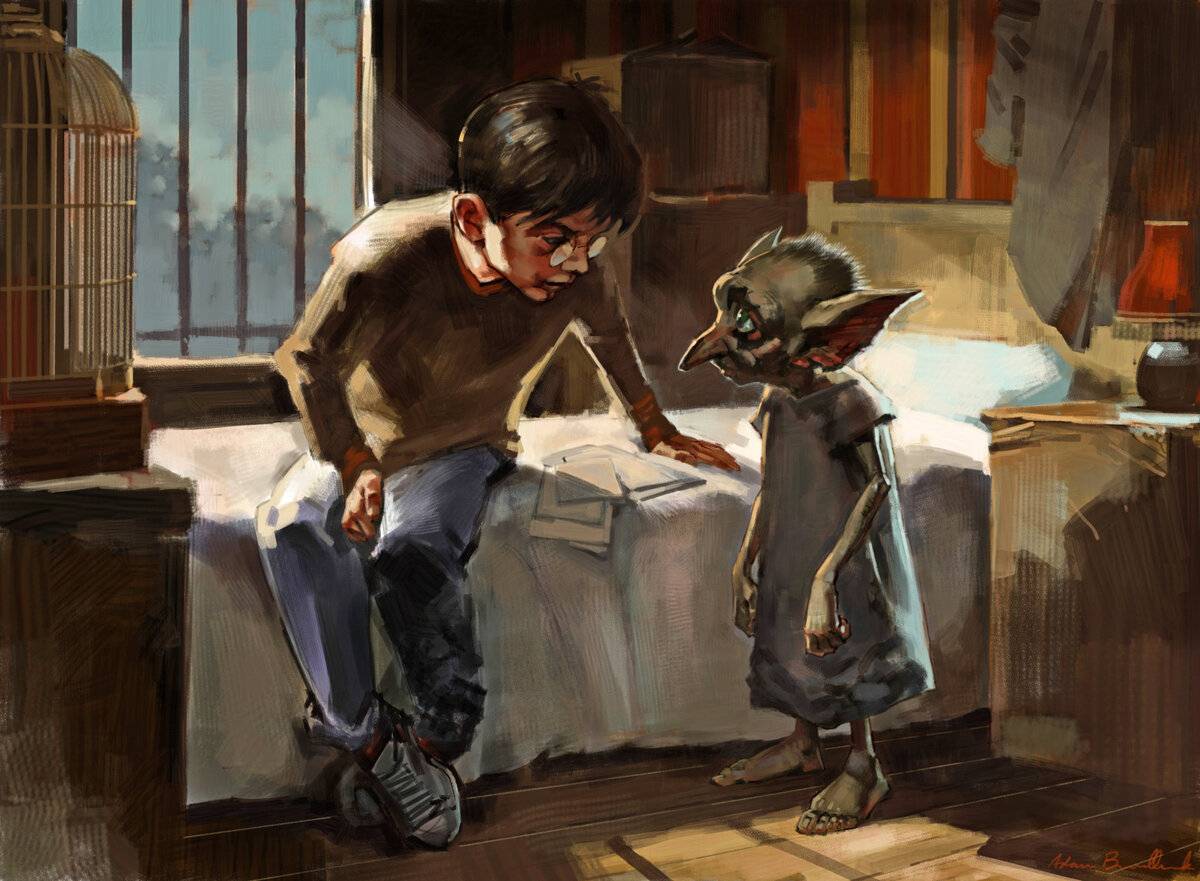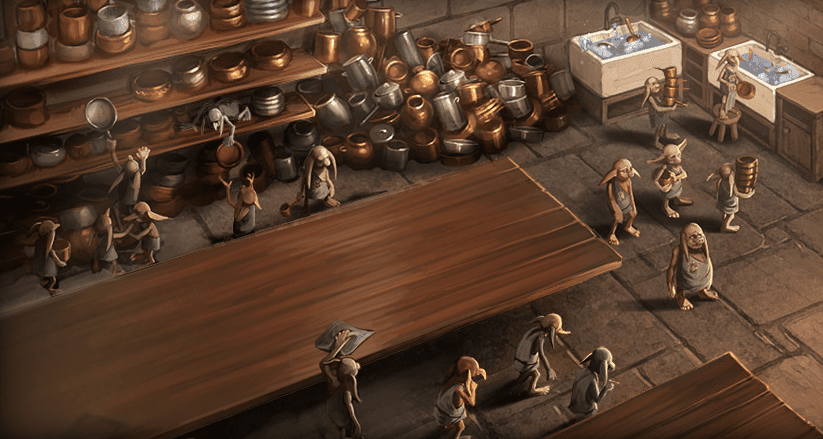House-elves
General Information
House-elves can best be pinpointed by their unwavering devotion to their masters and their standing as a status symbol for rich, often pureblood, households. These creatures are capable of human speech and hold incredible magical ability, their wandless talent often trumping that of a typical witch or wizard. Often overlooked is the house-elves fierce loyalty to those whom they pledge devotion to.

Physical Appearance
Small and bug-eyed, house-elves stand at a height of about three feet tall and boast large ears, flat feet, and long fingers. The color of their skin varies, as does the color of their eyes, but all house-elves share the commonality of gigantic eyes that seem to bulge out of their heads. Their skin is often wrinkled and knobby at the joints. House elves can wear a variety of clothing, depending on the clothing they are given by those whom they serve.
Magic
House-elves, as previously mentioned, have incredibly powerful wandless and nonverbal magic. They are capable of feats such as levitation, apparition, and summoning. House-elves, oddly enough, have an innate ability to recognize when they are needed. For example, in the year 1997, a house-elf owned by the infamous house of Black by the name of Kreacher was summoned by the notorious Harry Potter. Kreacher apparated to Potter's location, despite their previous distance. These magical abilities are not taught, as in wizards, but rather are understood from birth and grow in strength as the house-elf in question gets older.
Servitude
Since the beginning of wizardkind, house-elves have always been bound to a master. It is uncertain how house-elf ownership began, but the use of house-elves as personal janitors and housekeepers in the homes of wizarding families. The use of a house-elf is often seen as a status symbol in the pureblood community, as owning a house-elf cements you as someone who upholds traditional pureblood standards and beliefs.
House-elves are passed down from generation to generation, as they have quite lengthy lifespans of about 200 years. In their households, house-elves take care of chores like cooking, cleaning, dishes, and even interior design. The only known way that a house-elf may be freed from servitude is by being presented clothing by their master.
House-elves may also be employed by government agencies or, in the case of Hogwarts, schools. In the case of the North American wizarding government, MACUSA, house-elves work as wand-polishers and janitors. At Hogwarts School of Witchcraft and Wizardry, located in Europe, house-elves work as cooks in the school kitchens.
Even when not under the direct servitude of a household, house-elves may pledge their loyalty to individual witches or wizards and attempt to aid them in any way they may see necessary. One such instance of this is in the case of Harry Potter and Dobby, a notable house-elf.

Culture
House-elves, unfortunately, due to their history as the household possessions of wizarding families, do not have a set sense of culture among their species. Their lack of connection with one another due to their closeness with wizardkind has come with its own set of hurdles, such as the lack of the ability to unionize as a species or demand better working conditions.
If multiple house-elves work in the same proximity, such as in the case of the Hogwarts house-elves, they may form small 'villages' of sorts. One thing that is universal among house-elves is a love for coziness and the expression of personality. In the Hogwarts kitchens, a wall of barrels stacked high to the ceiling functions as the home of the Hogwarts house-elf population. Small lights shine through the windows that are inlaid in the sides of the barrels, and, utilizing their powerful magic,
these barrels are far larger on the inside than on the outside. To stay true to their personalities and creative tendencies, the interiors of these barrels are heavily decorated and painted by the house-elf inhabitants.
Interestingly, and often unknown to the general population, house-elves are incredibly artistically talented and enjoy painting a great deal. In recent history, a particular house-elf artist has gained notoriety for her beautiful use of color and her highly professional works: the house elf Dopmey the Dazzling (self-titled) specializes in gouache painting and serves no master, which is seen as quite liberating and unique amongst the general house-elf population.
Elf Legislation & Guidelines on House-Elf Welfare
Elf legislation, more specifically the Ministry of Magic's Guidelines on House-Elf Welfare, have been in effect since as early as 1867. These guidelines detail the expectations when it comes to the employment of house-elves, but, unfortunately, these guidelines are often ignored and unenforced, leading to the common mistreatment of house-elves. Such mistreatment can include physical torment, the establishment of poor living conditions, lack of attention, and verbal aggression. Notably, in a practice popularized by Elladora Black, house-elves who began to get too old to carry tea trays would be beheaded and mounted on the wall in the famed Black family household.
The guidelines detail exactly how a house-elf should be treated when in the servitude of a wizarding family or institution, detailed in the document below:Unfortunately, these guidelines have historically been notoriously short and do not cover issues akin to unionization, free elves, or any form of elf-centric government. Furthermore, their detailing of house-elves as property attached to an estate is the cause of uproar and is subject to change. Because of the ignorance of the government and the lack of proper legislation in the case of house-elf welfare, movements advocating for the proper treatment of house-elves have become far more prevalent since the year 2000. Advocates campaign for kindness towards elves and the implementation of days off, vacations, and the establishment of house-elf-centric government branches.Guidelines on
House-Elf Welfare
Section 1. Compensation. In the case of house-elves employed by estates, house-elves should be compensated by, at the very least, free room and board. In the case of house-elves employed by institutions (i.e. schools, government agencies, small businesses, etc.), house-elves should be compensated by both free room and board and additional monetary payment.
Section 2. Treatment In the Workplace. House-elves should be treated as a member of the estate and are not to be harmed by employers. House-elves found to be routinely mistreated in their profession may be seized upon Ministry intervention and therefore employed elsewhere.
Section 3. Employment. In the case of house-elves and their attachment to estates, house-elves should be detailed in the will of the owner of an estate separate from the estate itself, and mastership of a house-elf cannot be assumed in a court of law.
In the case of Hermione Granger, a Minister for Magic, additional guidelines were added and the codes were amended to mention that house-elves, in this day and age, are legally not property and absolutely must be paid for their servitude. This amendment was well-received and the status of family elves as pieces of property to be left in wills to other members was taken out.
*Lore by Sabine Blumenthal
This is the "Game Master" account. Please do not owl this account, unless specified. This account is not moderated actively and therefore, you may not receive a response.
Contact a Head of House or the Headmaster if you need anything.